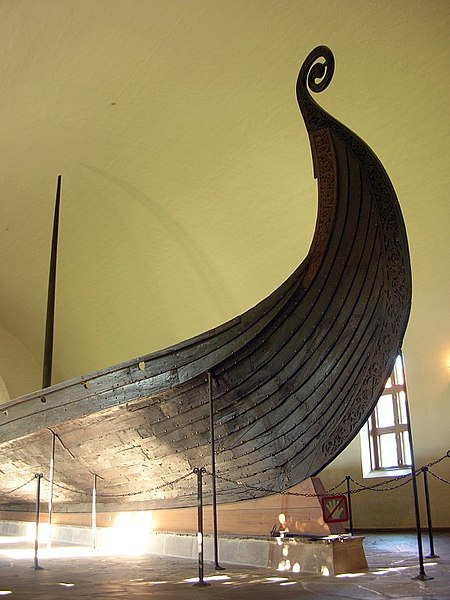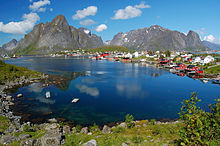CLIMATE
The climate of Norway is much more temperate than expected for such high latitudes; this is mainly due to the North Atlantic Current with its extension theNorwegian Current raising the air temperature ([4]), and the prevailing southwesterlies bringing the mild air on shore, as well as the general southwest - northeast orientation of the coast allowing the westerlies to penetrate into the Arctic. The January average in Brønnøysund [5] is almost 15 °C (27 °F)warmer than the January average in Nome, Alaska,[6]even if both towns are situated on the west coast of the continents at 65°N. In July, the difference is reduced to 3 °C (5.4 °F). January average inYakutsk, situated inland in Siberia but slightly further south, is 42 °C (76 °F) colder than in Brønnøysund.[7]
[edit]Precipitation
Some areas of Vestlandet and southern Nordland are Europe's wettest due to orographic lift, particularly where the moist westerlies first are intercepted by high mountains; this occurs slightly inland from the outer skerry guard. Brekke in Sogn og Fjordane has the highest annual precipitation with 3,575 mm (140.7 in); annual precipitation can exceed 5,000 mm (196.9 in) in mountain areas near the coast. Lurøy, near the Arctic Circle, gets 2,935 mm on average, a remarkable amount of precipitation for a polar location. Precipitation is heaviest in autumn and early winter along the coast, while April to June is the driest. The innermost parts of the long fjords are somewhat drier; annual precipitation in Lærdal is 491 mm (19.3 in), in Levanger 750 mm (29.5 in) and only 300 mm (11.8 in) in Skibotn at the head of Lyngenfjord, the latter also has the national record for clear-weather days. The regions to the east of the mountains (including Oslo) have a more continental climate with less precipitation, and enjoy more sunshine and usually warmer summers; precipitation is highest in summer and early autumn (often brief, heavy showers) while winter and spring tend to be driest inland. Valleys surrounded by mountains can be very dry compared to nearby areas, and a larger area in the interior of Finnmark gets less than 400 mm (15.7 in) of precipitation annually. Svalbard Airport has the lowest average annual precipitation with 190 mm (7.5 in), while Skjåk has the lowest average on the mainland with only 278 mm (10.9 in), the lowest ever recorded on the mainland is 64 mm (2.5 in) at Hjerkinn in Dovre. Monthly averages varies from 5 mm (0.20 in) in April in Skjåk to 454 mm (17.9 in) in September in Brekke. Coastal areas from Lindesnes north to Vardø have more than 200 days/year with precipitation; however, this is with a very low threshold value (0.1 mm precipitation). The average annual number of days with at least 3 mm (0.12 in) precipitation is 77 in Blindern/Oslo, 96 in Kjevik/Kristiansand, 158 in Florida/Bergen, 93 in Værnes/Trondheim and 109 in Tromsø.[8]
[edit]Temperature
The coast experiences much milder winters than other areas at the same latitudes. The temperature difference from the coldest month to the warmest is only 11–15 °C (52–59 °F) in coastal areas; some lighthouses have a year amplitude of just 10 °C (18 °F), such as Svinøy in Herøy with a coldest month of 2.7 °C (36.9 °F).[9] The amplitude of inland areas are larger, with a maximum of 30 °C (86 °F) inKarasjok. Finnmarksvidda has the coldest winters in mainland Norway, but inland areas much further south can also see severe cold;Røros has recorded −50 °C (−58 °F) and Tynset has a January average −13 °C (9 °F).
The islands in southern Lofoten are the most northerly locations in the world where all winter months have mean temperatures above 0 °C (32 °F).[10] Spring is the season when the temperature differences between the southern and northern part of the country is largest; this is also the time of year when daytime and nighttime temperatures differs the most. Inland valleys and the innermost fjord areas have less wind and sees the warmest summer days; the Oslofjord lowland is warmest with July 24-hr average of 17 °C (62.6 °F), but even Alta at70°N has July average of 13.5 °C (56.3 °F), and commercial fruit orchards are common in the innermost areas of the western fjords, but also in Telemark. Inland areas reach their warmth peak around mid-July, and coastal areas by the first half of August. Humidity is usually low in summer. The North Atlantic Current splits in two in the northern part of the Norwegian Sea; one branch goes east into the Barents Sea, while the other goes north along the west coast of Spitsbergen; this modifies the Arctic polar climate somewhat and results in open water throughout the year at higher latitudes than any other place in the Arctic. On the eastern coast of the Svalbard archipelago, the sea used to be frozen during most of the year, but the last years warming (graph) have seen open waters noticeably longer.
Normal monthly averages range from −17.1 °C (1.2 °F) in January in Karasjok 129 m (423 ft) amsl.[11] to 17.3 °C (63.1 °F) in July in Oslo - Studenterlunden 15 m amsl.[12] The warmest year average temperature is 7.7 °C (45.9 °F) in Skudeneshavn in Karmøy, and the coldest is −3.1 °C (26.4 °F) in Sihcajarvi in Kautokeino (excluding higher mountains and Svalbard); this is a 10.8 °C (19.4 °F) difference, about the same as the temperature difference between Skudeneshavn and Athens, Greece.[13]
The warmest temperature ever recorded in Norway is 35.6 °C (96.1 °F) in Nesbyen. The coldest temperature ever recorded is −51.4 °C(−60.5 °F) in Karasjok. The warmest month on record was July 1901 in Oslo, with a mean (24hr) of 22.7 °C (72.9 °F), and the coldest month was February 1966 in Karasjok with a mean of −27.1 °C (−16.8 °F). Southwesterly winds further warmed by foehn can give warm temperatures in narrow fjords in winter; Tafjord has recorded 17.9 °C (64.2 °F) in January and Sunndal 18.9 °C (66.0 °F) in February.
Compared to coastal areas, inland valleys and the innermost fjord areas have larger diurnal temperature variation, especially in spring and summer. In July, the average daily high temperature is 20.1 °C (68.2 °F) in Lærdal and 17.8 °C (64.0 °F) in Karasjok, roughly 3 °C(5.4 °F) warmer than coastal locations at the same latitude
 .
.



